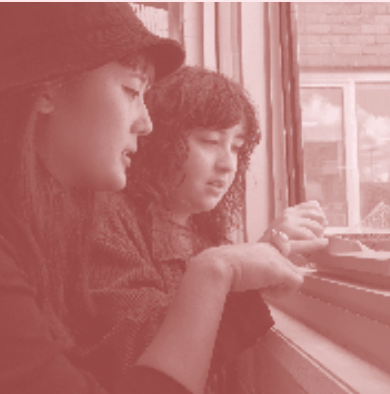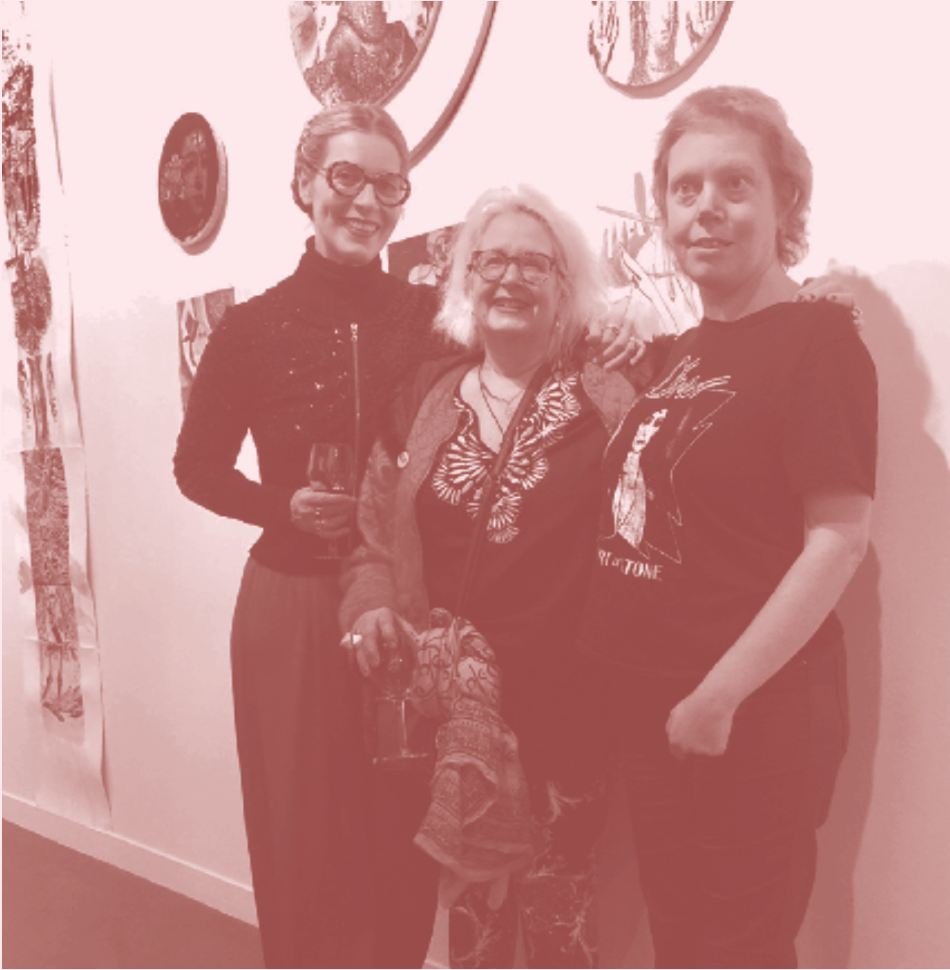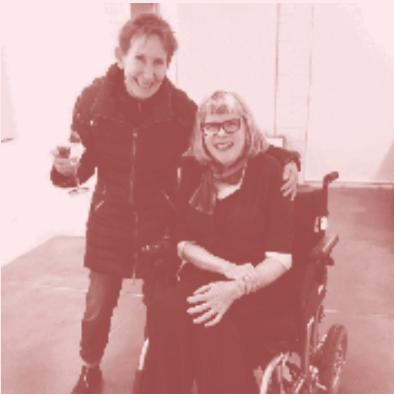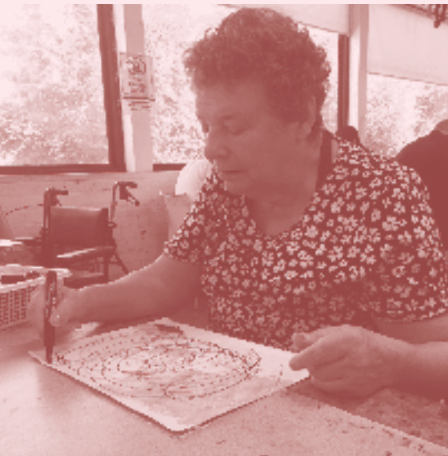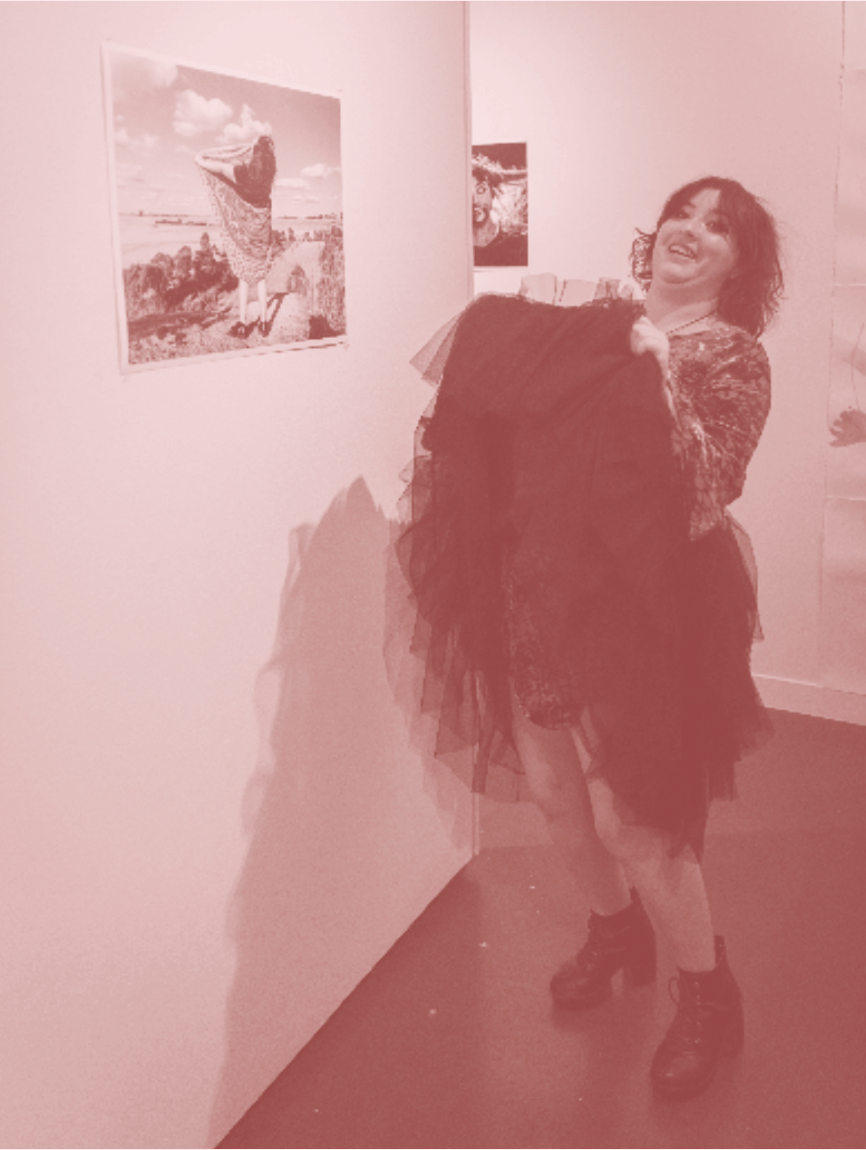If Collaboration Is the Method, Activism Is the Intention—
Catherine Bell
Associate Professor of Visual Arts
at the Australian Catholic University,
curator and multi- disciplinary artist
represented by Sutton Gallery, Melbourne
FEM-aFFINITY is an exploration of the synergies between the works of selected women artists and speculates on multiple interpretations of female identity. FEM-aFFINITY is a way of referring to all things ‘FEM’: it signposts how feminism underpins the curatorial premise and reinforces ways intersectional feminism can integrate disability voices, concerns and experiences into the broader art-world conversation. Here the emphasis centres on inclusion, and facilitating collaborations between the artists is integral to this project, especially as collaborative practices have a longstanding prevalence in feminist art, social movements and activism.
FEM-aFFINITY draws from socially engaged art that encourages shared perspectives, raising awareness of issues that face diverse communities and cultivating relationships within collaborative frameworks. The relaxed and welcoming atmosphere of Arts Project Australia’s open plan studio, where the artists work alongside each other, promotes creativity and community. This model creates a space that values relational processes of art-making and reinforces FEM-aFFINITY’s curatorial premise of ‘inclusion’ by linking artists from non-marginalised contemporary practice with their female contemporaries at Arts Project Australia to meet, share, observe, reflect and make artwork.
This approach shifts the discussion away from disability and focuses on the artistic interests, aesthetics, processes and social interactions of the Arts Project studio, and how this is grounded in feminist principles. Witnessing the different and reciprocal ways the artists collaborate illuminates concepts of interdependence, trust, friendship and embodied knowledge. It highlights how relational art practices have an affinity with feminism, but also further provokes the inverse question: Is feminism implicitly relational?
Incorporating both new and past works by the 14 artists, the exhibition positions the artists as contemporaries, acknowledging their longevity of practice and sustained visual enquiry. There is a distinction that must be made here: the curatorial intention is not to conflate all works in the show with feminism but, instead, to show uncanny correspondences and assert difference and diversity within art-making by female artists.
In this vein, Prudence Flint and Cathy Staughton explore female identity in their painted and drawn portraits of women in interior spaces. They diverge in how they relate to their subjects: Staughton paints others as herself, and Flint paints herself as others. At their first meeting, Flint gifted Staughton numerous exhibition catalogues depicting Flint’s work, and Staughton wasted no time reinterpreting the figures in her wild colour palette. Staughton brings the noise to Flint’s quiet pictures: her instantaneous re-creations belie the months Flint spends processing emotion as she methodically plans and executes her paintings. Spurred on by Staughton’s uncensored feelings and direct approach to art-making, Flint created a series of drawings showing couples in erotically charged yet somewhat awkward and unsettling embraces. These new works expose the deviant ‘eyes wide shut’ scenarios denied her painted female protagonists.
Meanwhile, Heather Shimmen and Bronwyn Hack share an interest in famous women of the past and their mysterious, unsolved or violent departures. At their first meeting, Hack shared with Shimmen the zines she writes and digitally illustrates. Her Gothic tales of medieval torture and death by guillotine resonated with Shimmen’s hand-printed artist books and her taste for true crime, vampires and mythological narratives.
In FEM-aFFINITY, it’s the medium of printmaking that provides the delivery of an exquisite corpse, where the artists share their fascination with the macabre and corporeal. Collaboration and the intuitive process are embedded throughout the work, mainly through the interchangeable, multi-panelled design – the cascading anatomy of lino prints adorned with primordial symbols is reminiscent of illuminated manuscripts, esoteric languages and mystical spells for conjuring the dead – not to mention the Frankenstein- esque arrangement of human and animal body parts. Skulls, bones, native flora and fauna produce a ghostly incarnation of the monstrous feminine.
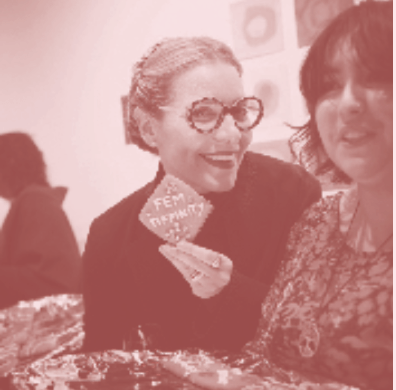
In a different pairing, Helga Groves and Wendy Dawson’s collaboration was initially challenged by Dawson’s visual language being her dominant form of communication. Viewing Dawson’s abstract paintings in the stockroom was reassuring for Groves: the artworks instantly spoke to her. It was exhilarating to observe Groves sort through the images and find an equivalent on her iPad that resonated with Dawson’s imagery; it was evident that the artists shared a profound affinity in colour palette and approach to repetitious mark-making. While the themes of their work may differ – Groves’ artworks explore geology and geophysical processes – Groves was drawn to an unusual copper-coloured drawing in Dawson’s portfolio. This work inspired Groves’ decision to work on copper panels, paving the direction of their collaboration. Groves visited the studio weekly with a selection of metallic pens, pearlescent papers and glistening minerals from her collection, and unobtrusively watched Dawson discover the rocks and excitedly work with the new materials. Focusing on scale, interwoven patterns and metallic mediums as common ground, their artworks distil embodied knowledge of the world around them into personal cartographies.
In contrast, Yvette Coppersmith and Lisa Reid have both painted portraits of prominent men in the arts. At their first meeting, they scheduled life- drawing classes at Arts Project Australia to sketch male nudes and shared their paintings of art-world identities, including curator Mark Feary and patron Peter Fay. Coppersmith noticed their subjects had coincidentally worn crisp, blue, button-up shirts to their portrait sessions, and an animated discussion ensued on the gravitas of the shirt, its charismatic rendering receiving more attention than the males wearing it. Adding
to this humorous exchange, Reid recalled she had phoned Fay to ask if she could paint his wrinkles. This request is a testament to her slavish attention to detail, much to the detriment of her subject’s vanity. Echoing this attention to detail, but with subversive intent, Coppersmith’s Blue Jeans Series (2007–08) consists of seven paintings of Mark Feary rendered like a Muybridge photographic sequence. unlike Reid, who requested permission to document Fay’s ageing complexion, Coppersmith surprised her sitter with multiple versions of himself on the gallery wall. In this way, both artists undermine power and authority, offering an empowering antidote to the male gaze by capturing their male subjects unapologetically and without compromise.
In another pairing, Janelle Low and Eden Menta critique the politics of difference through their photographic self-portraits. The artists present their bodies as sites of meaning to connect lived experience to understanding. Low and Menta have been committed to this process, meeting each week
at the Arts Project Australia studio and sharing their day-to-day lives, joys, heartaches and struggles. Low confirms their sense of ‘fem-affinity’ was strong from day one, emphasising that friendship is established through acts of interdependence and reciprocity.
Menta and Low regard the interpersonal moments as an integral part of the collaborative process. Their final works clearly reflect their supportive relationship, especially as the collaboration shifted from Arts Project Australia to the privacy of their respective homes, where the personal is amplified and the subject is documented candidly. These intimate portraits extend the conceptual reading from a politics of difference to a politics of care, showing how intersubjective perspectives evolve within collaborative partnerships.
An exciting collaboration transpired between Jane Trengove and Fulli Andrinopoulos. Independently, their works reveal the tension between abstraction and reality as well as the impact of repetitive processes, as their artworks manifest in multiple renderings of a circular form. Andrinopoulos’s celestial orbs – or portals – tease the eye into seeking something familiar in their colour and painterly elements. Though repeated endlessly, these works are not static: the round form morphs gently in/on its specific colour surround, making each work unique. Meanwhile, Trengove’s use of repetition conveys a sense of individuality in the many. Her artwork investigates the reliance on visual perception to inform meaning and knowledge. Hence, the experience of viewing Andrinopoulos’s work and working alongside her in the Arts Project Australia studio unlocked an immediate response in Trengove. She was stimulated to create new work with the circular form and repeat it, as she has done previously, but this time by directly invoking a celestial body. There is an undeniable affinity between Andrinopoulos’s and Trengove’s methodology, and yet their works remain entirely distinct. The pairing shows a kinship of practice where both artists work freely with an infinite mind space and within the structures of contemporary art.
Finally, Jill Orr and Dorothy Berry share mutual respect and appreciation of the natural world. Although they haven’t collaborated on new work for the show, their inclusion acknowledges their vital contribution to Australian art. Berry is a veteran at Arts Project Australia, being the longest attending and oldest artist, at the age of 77. Meanwhile, Orr is a stalwart of the Australian art world and has influenced generations with her internationally renowned, multidisciplinary practice. Both artists have inspired audiences through decades of creating and exhibiting their art. Seminal works from each artist represent the start of their careers through to the present and demonstrate how the bird motif has an enduring presence in their practices.
Providing an alternative context for artists to create art, and for audiences to view their art, FEM-aFFINITY expands the vision of a given work. Over several months the artists have shared their lives, mutual interests and artworks. They have discussed their processes and discovered overlapping subject matter, materials and methods. Their openness to engaging collaboratively, responsively and reflectively exemplifies the generative approach of social relations and its capacity to broaden social margins as well as the scope of an artist’s practice.
